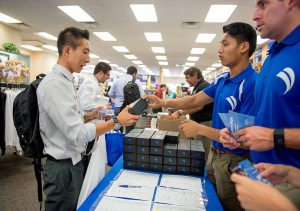COMP implements innovative solution for medical student ultrasound training

Hundreds of students from Western University of Health Sciences’ College of Osteopathic Medicine of the Pacific (COMP) received SonoSim® ultrasound training probes and software during a distribution day at the University Bookstore.
Medical students will be able to convert their own laptops into full-scale ultrasound training simulators, paving the way for them to be more competitive in the residency market and patient care.
SonoSim distributed the ultrasound probes to first-year medical students Wednesday, August 3, 2016, during the University’s Welcome Week. Second- and third-year medical students and College of Podiatric Medicine students will also be incorporating them into their curriculum and will receive the ultrasound probes and training.
“I think it’s excellent,” first-year COMP student Jin Lee said of the ultrasound training probe. “I was going to join the Ultrasound Club. It’s a good thing to know for a student doctor.”
COMP Director of Clinical Education Natalie Nevins, DO ’97, MSHPE ’97, said the SonoSim ultrasound training solutions would be issued like any other piece of equipment, similar to the way stethoscopes and ophthalmoscopes are used during four years of medical education.
“We are now in the 21st century, and ultrasound has a much larger role in the diagnostic aspects of medical care,” Nevins said. “Ultrasound is literally being used in every arena and every specialty in some way — OB, internal medicine, family medicine, pediatrics and the musculoskeletal system.
“This is important because of the unification of the AOA and ACGME for residency training, and (because) the allopathic schools in Southern California, pretty much all of them, are using SonoSim for training,” she continued. “We felt we should provide this additional training for our students so they would be competitive.”
Nevins said students will learn ultrasound as part of their core curriculum in Essentials in Clinical Medicine (ECM) from day one, implementing the probes into the flipped classroom. They also will be integrated into anatomy classes. In the future, radio-frequency identification (RFID) chips can be placed in simulated patients and used in Observed Structural Clinical Examinations (OSCEs) during didactic week.
“It is absolutely in league with our intentions of more flipped classrooms, allowing the students to learn at their own pace, and these modules are completely self-imposed,” Nevins said. “This way, when we bring them back together for small and large groups, they get to spend time doing hands-on exercises, and will be able to apply the skills they have learned, practicing with a probe on a real ultrasound machine.”
SonoSim Vice President Dan Katz, MD, FACEP, said that medical schools such as WesternU are capitalizing on providing ultrasound training to students.
“SonoSim facilitates asynchronous learning, enables self-assessment, allows instructors to track progress, and provides an opportunity to ‘train-the-trainers,’” Katz said. “Students learn how to apply these ultrasound findings toward clinical decision-making.”



